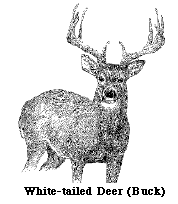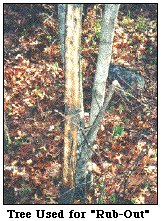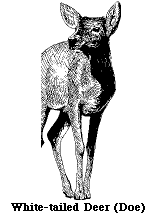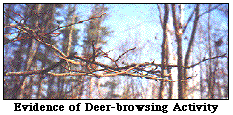Both deer and moose are large hoofed mammals that belong to the Cervidae or deer family, whose members are found only in the Northern Hemisphere. A main characteristic of both animals is the presence on the head of the male of a pair of solid calcareous antlers that are shed and grow anew each year.
Hackett Hill deer are white-tailed deer (Odocoileus virginianus). They are about six feet in length and 3 to 4 feet high, and have a reddish or grayish color. A male deer, or buck, may weigh as much as 400 lbs.
 On Hackett Hill,
deer habitat is generally that of "deeryards" at the periphery of the
swamps or densely-wooded areas. Here trees are sparser and shrubs are
fairly abundant. Deer "browse", or nibble the growing tips of
saplings or shrubs, and evidence of this activity can be seen
whereever the tips of the plants have a blunted appearance.
On Hackett Hill,
deer habitat is generally that of "deeryards" at the periphery of the
swamps or densely-wooded areas. Here trees are sparser and shrubs are
fairly abundant. Deer "browse", or nibble the growing tips of
saplings or shrubs, and evidence of this activity can be seen
whereever the tips of the plants have a blunted appearance.
Antlers are shed and regenerated yearly in male deer. The gradual accumulation of bony tissue by these structures eventually closes off the blood vessels passing through them, and when the epidermal covering or "velvet" on the outside of the antlers is deprived of this blood supply, it peels off. Shedding of the remaining hard antler mass occurs later, after bone-destroying cells have eroded the bone at the junction of the antlers and pedicles. The wound heals over rapidly and growth then begins anew. Shedding generally occurs in the late winter, regeneration occurs during the summer months, and the peeling of the velvet takes place just before the breeding season in the fall.
Bucks attempt to remove the dead
tissue or "velvet" on their antlers by  rubbing the antlers against trees. Trees where the bark
has been worn away and horizontal markings appear indicate that a
buck used the tree for its "rub-out" activity.
rubbing the antlers against trees. Trees where the bark
has been worn away and horizontal markings appear indicate that a
buck used the tree for its "rub-out" activity.
 The
peak of the breeding season, which generally occurs late in the fall,
is known as the "rut". A doe (female deer) that has bred,
subsequently enters into a gestation period of about 7 months.
New-born deer are known as fawns and have a spotted coloration. After
about 4 weeks, fawns are capable of eating solid food and can travel
about with their mother.
The
peak of the breeding season, which generally occurs late in the fall,
is known as the "rut". A doe (female deer) that has bred,
subsequently enters into a gestation period of about 7 months.
New-born deer are known as fawns and have a spotted coloration. After
about 4 weeks, fawns are capable of eating solid food and can travel
about with their mother.
Credits: The drawings of the white-tailed deer were located on
the About.com
Guide to Environmental Issues. The
artist is Robert Savannah.
